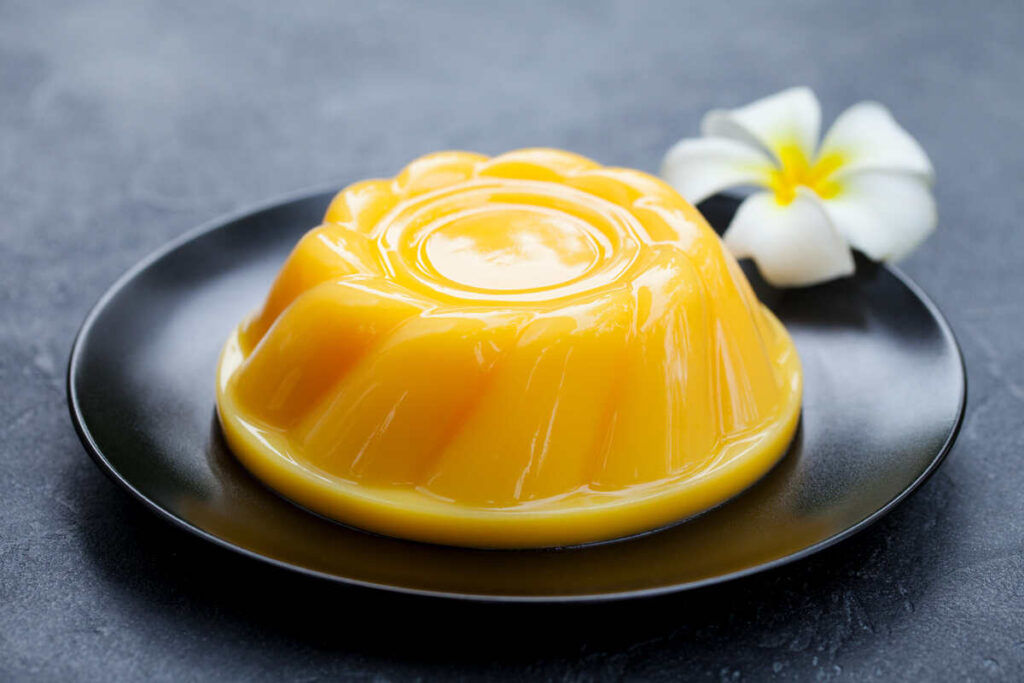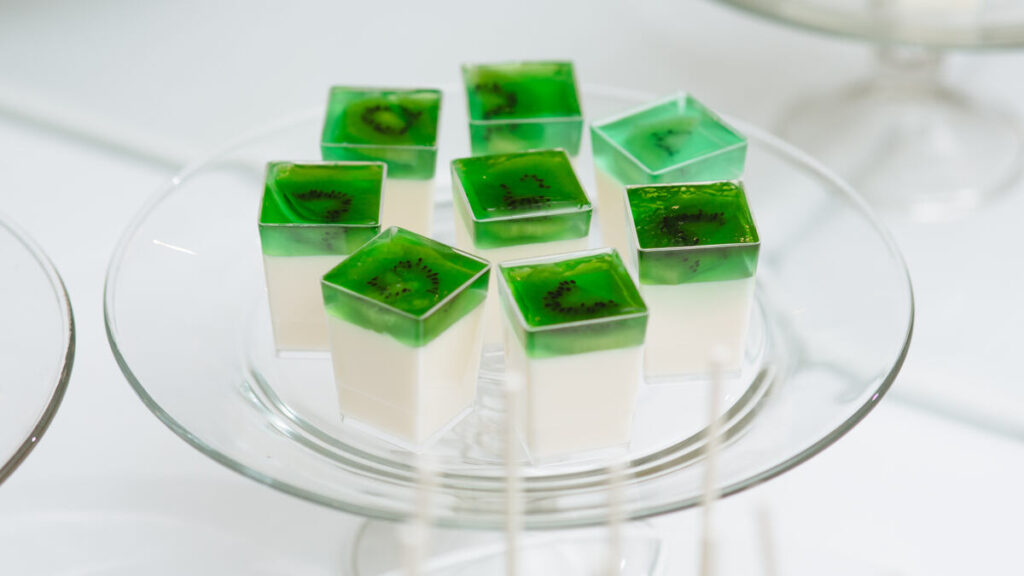
Although pork and beef gelatin dominate the current market, more and more consumers are turning their attention to a lesser-known alternative – fish gelatin. Appreciated for its mild taste and compatibility with kosher and halal diets, fish gelatin is used in confectionery, gastronomy, pharmaceuticals, and even cosmetics. Made from fish skins and bones, it offers unique properties that make it a valuable ingredient in desserts, creams, and premium products, serving as an attractive alternative to traditional gelling agents.
Fish Gelatin
Fish gelatin is a natural gelling agent derived from fish skins and bones, known for its versatility and neutral taste. It typically comes in the form of powder, granules, or thin, transparent sheets. Once soaked and dissolved, it efficiently thickens liquids, giving them the desired texture and elasticity.
Characteristics of Fish Gelatin
Fish gelatin stands out from pork and beef gelatin primarily due to its lower melting point, which is around 30°C. This feature allows dishes prepared with its addition to achieve an exceptionally delicate, melt-in-the-mouth texture, highly valued by chefs and pastry professionals worldwide. It is an excellent choice for high-end culinary applications, especially when producing kosher or halal sweets – such as gummies, marshmallows, or jellies.
Just like other types of gelatin, fish-derived gelatin produces a clear gel that is free from strong taste or smell, allowing it to blend seamlessly into a variety of recipes without altering their character. Before use, it must be soaked, which enables it to fully dissolve and activate its gelling properties. However, fish gelatin is not merely a substitute for pork or beef versions – its unique functional qualities make it ideal for creating lighter desserts, softer creams, and elegantly textured sauces.
The growing popularity of this type of gelatin is driven not only by the needs of consumers seeking kosher and halal options, but also by a broader trend toward natural, minimally processed ingredients. As a result, fish gelatin in sheet or powdered form is increasingly favored by professional pastry shops, fine-dining restaurants, and premium food manufacturers across the globe.
Differences in Gelling Strength of Fish Gelatin
One of the key characteristics that distinguishes fish gelatin from its pork and beef counterparts is its gelling strength, expressed in Bloom units.
Fish gelatin derived from cold-water species such as cod typically contains lower levels of the amino acids proline and hydroxyproline, which are responsible for the stability of the gelatin network. As a result, gels made from this type of fish gelatin tend to have a more delicate structure and reduced thermal resistance. While this might appear to be a limitation, it can actually be an advantage when preparing ultra-smooth, creamy desserts with a refined texture.

On the other hand, fish gelatin obtained from warm-water species, such as tilapia or Nile perch, contains higher concentrations of these stabilizing amino acids. This allows it to reach gelling parameters comparable to those of pork or beef gelatin, making it a versatile ingredient also suitable for the production of sweets, savory aspics, and other processed foods.
This variation in composition and gelling strength is precisely what makes fish gelatin so valuable in both professional kitchens and the food industry. It offers broad possibilities for tailoring the texture of dishes and products to meet consumer expectations and technological requirements.
The Process of Making Fish Gelatin
Fish gelatin is produced from by-products of fish processing – primarily skins, scales, and bones. Using these parts makes the production process environmentally friendly, as it allows for the maximum utilization of available raw materials.
The process begins with thorough cleaning and preparation of the fish tissues – all remaining meat, fat, and impurities are removed. At this stage, mild acidic or alkaline solutions are also applied to help obtain a product with a light color and neutral smell. Once prepared, the raw material is ready for the extraction of collagen – the key protein that, once processed, becomes gelatin.
Collagen is released from the tissues through gentle heating in water at a temperature between 40°C and 80°C. During this stage, the long protein fibers break down into shorter chains, and the resulting solution begins to develop gelling properties. Today, this process is increasingly supported by enzymes, which accelerate hydrolysis and increase production efficiency. Thanks to this, fish gelatin retains high purity and a mild taste, while being produced faster and in greater volumes.
After extraction, the solution undergoes multi-stage filtration and clarification, with the goal of achieving maximum clarity and flavor neutrality. Next, the water is evaporated, and the dry mass is formed into user-friendly flakes, powder, or granules. This form not only facilitates storage and measuring, but also makes fish gelatin an extremely versatile ingredient – ready for use in cooking, pharmaceuticals, or cosmetics.
Fish Gelatin and Its Properties
Fish gelatin is a unique ingredient that stands out not only for its gelling ability, but also for its rich amino acid profile and broad functional potential, highly valued in both the food industry and the nutraceutical sector. It provides easily digestible collagen protein, which supports the body’s natural regenerative processes. It is also a source of glycine and proline – amino acids essential for the health of skin, joints, and the digestive system. Thanks to its natural structure, fish gelatin is gentle on the stomach and well tolerated, even by those with sensitive digestive tracts, making it a valued component in functional foods and dietary supplements.
Its high purity and neutral taste have earned fish gelatin a reputation as a premium raw material. Its use aligns perfectly with the growing trend of sustainable food production – since it is derived from parts of fish that would otherwise go to waste, it helps reduce resource waste and minimize the environmental footprint of the fishing and seafood processing industry. It is also increasingly sought after in sectors that emphasize natural and minimally processed ingredients, making it a smart choice for both manufacturers and health-conscious consumers.
Fish Gelatin vs. Its Pork and Beef Counterparts
Fish gelatin is increasingly recognized as a nutritionally valuable alternative to pork and beef gelatin. However, differences in its composition and functional properties mean that it is often used in slightly different applications. The most distinctive feature of fish gelatin is its lower melting point – a dessert or cream prepared with it tends to melt more easily in the mouth, enhancing the sensory appeal of the dish. This characteristic is especially appreciated in professional confectionery and gastronomy.
In terms of gelling strength, fish gelatin often falls behind mammalian gelatin, particularly when derived from cold-water fish. This is due to its lower content of key amino acids such as proline and hydroxyproline, which are essential for the stability of the gel network.
Compared to pork and beef gelatin, fish gelatin also stands out in ethical and religious contexts – it is a natural choice for individuals who follow kosher or halal dietary laws. Moreover, its production aligns with zero waste principles, as it is made primarily from fish-processing by-products, helping to minimize raw material losses and promote sustainable resource use.
Uses of Fish Gelatin
Fish gelatin is a highly valued ingredient with a wide range of applications. Thanks to its neutral taste and high purity, it is widely used across various industries.
- In gastronomy and confectionery, it serves as a natural thickener and stabilizer. It facilitates the preparation of jellies, creams, mousses, and no-bake cheesecakes, giving them a smooth texture and clear appearance. These properties also make fish gelatin ideal for producing premium desserts and modern convenience foods, where quality and visual appeal are key.
- Fish gelatin also plays an important role in pharmaceuticals and supplementation. It is a popular base for soft capsules, tablet coatings, and collagen supplements that support the health of skin, joints, and bones. Its high degree of purification and natural origin make it a safe carrier for active ingredients, while its adaptable gelling parameters allow for precise customization to meet manufacturers’ specifications.
- In cosmetology, fish gelatin is increasingly used for its moisturizing and film-forming properties. It is sometimes used as a base for facial masks, serums, body lotions, and hair and nail conditioners. Its bioactive peptides support skin regeneration and overall skin health.
In short, the versatility and functionality of fish gelatin make it not merely an alternative to other gelling agents, but a fully fledged premium raw material that brings together culinary performance, health benefits, and technological value.

Conclusion – Fish Gelatin as an Ingredient of the Future
Fish gelatin is a product that is gradually gaining recognition not only in gastronomy, but also in the pharmaceutical and cosmetic industries. Its neutral taste, high purity, and versatile properties make it not only an alternative to other types of gelatin, but a fully-fledged premium ingredient. What’s more, its production supports the idea of sustainable development, as it makes use of raw materials that would otherwise go to waste.
The growing interest in healthy food, dietary supplements, and natural cosmetics suggests that the importance of fish gelatin will likely continue to rise. It is an example of a material that blends innovation with tradition, while also meeting the expectations of increasingly conscious consumers. All these factors make fish gelatin a promising ingredient for the future, one that will likely become more and more common in everyday products.
Source:
- https://www.sciencedirect.com/topics/food-science/fish-gelatin
- https://pmc.ncbi.nlm.nih.gov/articles/PMC11394984
- https://patents.google.com/patent/US5093474A/en
- https://www.mdpi.com/2073-4360/14/4/751



